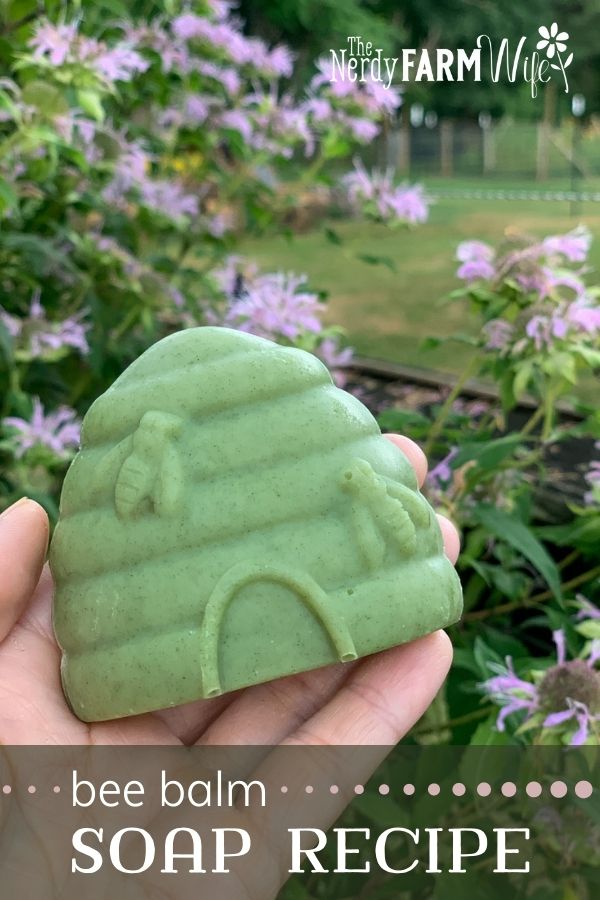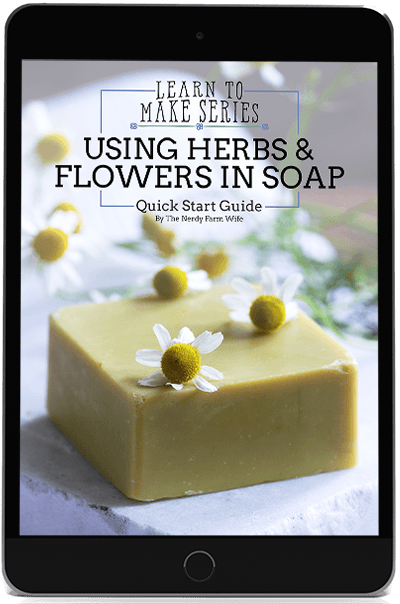Triple Bee Balm Soap (cold process)
For this recipe, I gathered bee balm flowers and leaves, dried them, then made an oil infusion and a tea. I also had some additional bee balm infused honey on hand (it’s a good herbal remedy for sore throats), so added that to the mix as well.
Bee Balm (Monarda fistulosa), also called wild bergamot, is a lovely wildflower or garden flower in the mint family. It attracts all kinds of pollinators, including hummingbird moths, bees, and butterflies.
You can learn more about growing and using bee balm, plus how to make bee balm honey, in an article over at our family site, Unruly Gardening:
How to Grow Bee Balm + 8 Ways to Use It
Bee balm doesn’t add much color to soap, so a small amount of chlorella powder (a single celled algae used as a nutritional supplement) is used to give a pretty green color that softens over time.
Be aware that the soap batter will look very dark green or green-brown when you mix and pour it into the mold, but it lightens up over time to the color shown in the photo.
Cure and store finished bars out of sunlight or direct indoor lighting, since natural greens tend to fade easily over time when exposed to light.
You can also find this soap recipe in my free Guide to Using Herbs & Flowers in Soap, a bonus when you sign up for my weekly newsletter called Soap Tip Tuesdays!
Some links on this site are affiliate links; I only recommend products I personally use and enjoy. As an Amazon Associate, I earn from qualifying purchases.
Ingredients
Oils, lye, and water/tea are all listed by weight. You must use a scale to make soap.
Lye Solution
- 4.1 oz (116 g) cool bee balm tea (2.1:1 water to lye ratio)
- 1.95 oz (55 g) sodium hydroxide (lye) (5% superfat)
- Optional: 1 tsp sodium lactate
Oils & Butters
- 4 oz (113 g) olive oil, infused with bee balm flowers and leaves (29%)
- 3.5 oz (99 g) coconut oil (25%)
- 3 oz (85 g) sunflower oil (21%)
- 2.5 oz (71 g) kokum or refined cocoa butter (18%)
- 1 oz (28 g) castor oil (7%)
- 1 tsp chlorella powder
- Optional: 5 drops rosemary antioxidants (to extend shelf life)
Add at Trace
- 1 tsp honey (optionally infused with bee balm), mixed with 1 tsp water
- Optional essential oil blend: 7 g lavender, 4 g bergamot, 0.5 g rosemary
To make bee balm tea for soap: fill a jar 1/4 way with dried bee balm flowers and leaves, or 1/2 way with fresh bee balm flowers and leaves. Pour simmering hot water over the herbs and let steep for about 20 minutes. Strain and cool before using in soap.
If you’ve never made soap before, please read my Soapmaking 101 article before proceeding, or go through the Introductory Guide to Soapmaking in my Soapmaking Success course.
The mold used is from Bramble Berry: 6 Cavity Beehive Silicone Mold
Directions to Make
- Put on goggles and gloves.
- Weigh the cool or cold bee balm tea into a stainless steel or heavy duty plastic container.
- Weigh the lye into a small cup.
- Sprinkle the lye into the cold tea and stir until dissolved. (Don’t breathe in the temporary, but strong fumes.)
- It’s normal for the lye solution to turn a bright orange or orange-brown color when the lye is added.
- Cool the lye solution in a safe spot for 30 – 40 minutes, or until about 100 to 115 degrees F.
- Stir in the sodium lactate if using. (Sodium lactate helps harden soap and makes it easier to unmold.)
- Melt the kokum (or cocoa) butter with the coconut oil in a small saucepan, then combine with the other oils.
- Stir in the chlorella powder for color, and rosemary extract into the oils, if using, to help extend shelf life.
- Pour the cooled lye solution into the warm oils.
- Start by hand stirring the soap.
- Next, use brief short pulses of the immersion blender, interspersed with hand stirring, until soap reaches light trace. (Don’t run the stick blender continuously.)
- Stir in the honey and essential oils, if using.
The soap batter will look very dark at this point, but the color will lighten over time. - Pour soap into molds.
- Let sit for about 15 minutes, then cover lightly with a sheet of wax paper sprayed with baking spray, or a piece of parchment paper. (Not overfilling + waiting + spray/parchment helps keep the soap from sticking to the covering.)
- Uncover after 24 hours in the mold. Keep the soaps in their mold for 1 to 2 days or until easy to remove. If you used sodium lactate, they should be ready to unmold after the initial 24 hours.
- Cure the soaps on sheets of wax paper in the open air, turning occasionally. Handmade soaps should be cured at least 4 to 6 weeks before using, for best mildness and lather.
If you run into trouble with your soap, check out my extensive Troubleshooting Guide:
What’s Wrong with My Soap? (troubleshooting cold process soap problems)




